With 400 million users and counting, LinkedIn has emerged as the most useful social network for B2B marketers.
Facebook, Twitter and the rest are crowded and noisy. Sure, LinkedIn is busy too, but it’s a destination for people to connect with peers and learn about their industry. If you’re looking to drive traffic to your B2B blog, this is your platform.
According to a study by Econsultancy, “LinkedIn is now responsible for a staggering 64% of all visits from social media channels to corporate websites.”
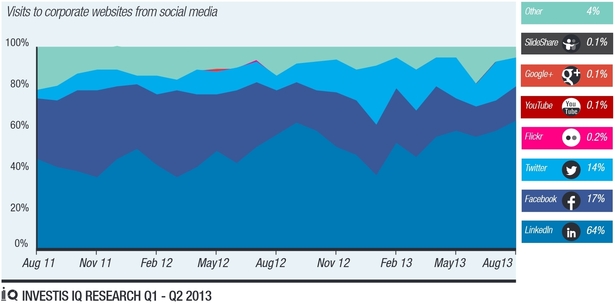
Image via Econsultancy
Even more insane, 90% of all social traffic to B2B websites comes from Facebook, Twitter and LinkedIn, with LinkedIn accounting for more than half. In case you didn’t catch that, more than 50% of all social traffic to B2B sites comes from LinkedIn.
Yea.
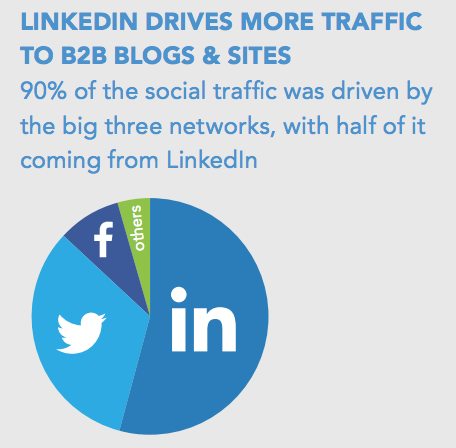
Source: LinkedIn
LinkedIn is an awesome traffic source and probably totally underutilized in your own marketing. I bet you want in. Don’t worry, we’ve got you covered. Here are 8 ways to start driving traffic from LinkedIn today.
- Optimize Your Personal Profile
- Join Groups
- Start a Group
- Create a Company Page
- Share Often
- Add a LinkedIn Share Button to Your Site
- Republish Content
- Pay For It
1. Optimize Your Personal Profile
Several of the other strategies in this post are designed to funnel traffic through your LinkedIn profile page so let’s start here.
First, ensure you’ve got the basics right. You should have a good headshot, a brief summary that introduces your work, and a concise history of your work experience. Don’t overlook the importance of these fundamentals.
See how good I look?
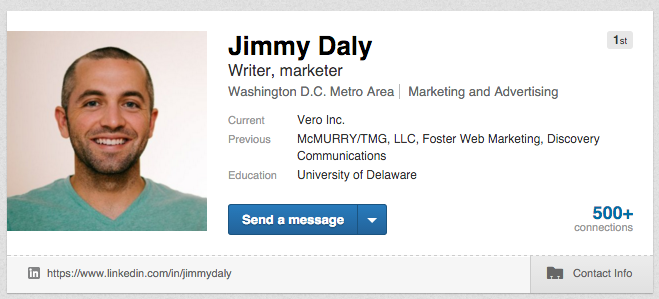
There are many ways and reasons to optimize your profile. Here are a few, courtesy of Aaron Clayton-Dunn:
- Write a summary that clearly explains what you do (or what you’d like to do.
- Make it easy for people to contact you via email or LinkedIn.
- “Be honest, be specific, and use numbers when possible.”
- Read your profile out loud to look for typos.
Now for that bit about driving traffic. Pay attention because this is very important. You can link to blog posts, e-books and other digital media in your profile. Once we start using the other strategies to get people viewing your profile, this is how they click-through to your site.
Go to your profile and look for the Summary section. Here, you can add media like blog posts.

Add a link to one of your best posts. Keep in mind that people who end up here are likely learning about you and your company for the first time. Share content that will inspire them to click-through and read.

Add some details about the post.

Your media will appear in your Summary, which is one of the first things people see when viewing your profile.
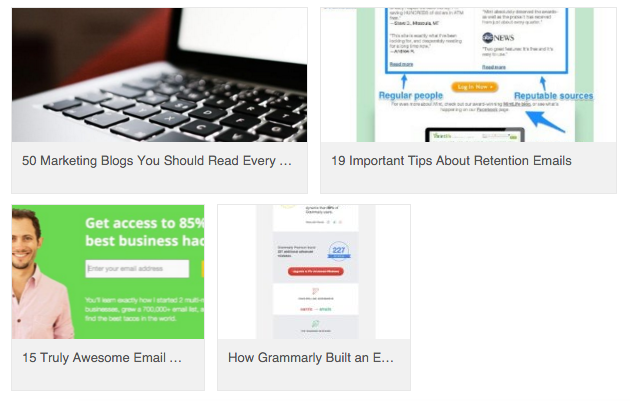
It’s really important to add media in the Summary section. LinkedIn might ask you to add Publications or Projects. You can create external links with those features, but they appear at the bottom of your profile. Stick to the Summary for maximum exposure.
2. Join Groups
Now, let’s drive some people to your profile. Joining and participating in groups can be a great way to do this.
One of the Golden Rules of content marketing is that you cannot expect to get traffic without giving something in return. Typically, you give value, knowledge and inspiration. The same is true for LinkedIn, but I recommend taking off your marketing hat to get started.
LinkedIn Groups — here's the massive directory — are a great way to network with peers and potential customers. Promotion is often frowned upon, which is why you’ll need to get comfortable engaging in discussions that don’t result in immediate traffic to your site. The more you help people, the more profile views you’ll get. And if you’ve added media like I described above, you’re in a great position to earn traffic.
Here are a few tips to help you get started.
Step One: Browse the directory or use the search bar to find groups. Use the filters to see only groups.
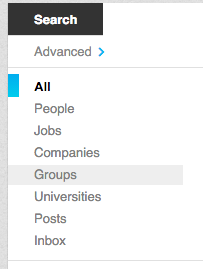
You can see that a search for “email marketing” returns more than 900 results and hundreds of thousands of users. Join the most targeted groups first and start participating before you join more. It can be overwhelming at first since you’ll start receiving emails and notifications from each group. It’s best to experiment with a few groups so you can fail small before trying to scale this strategy.
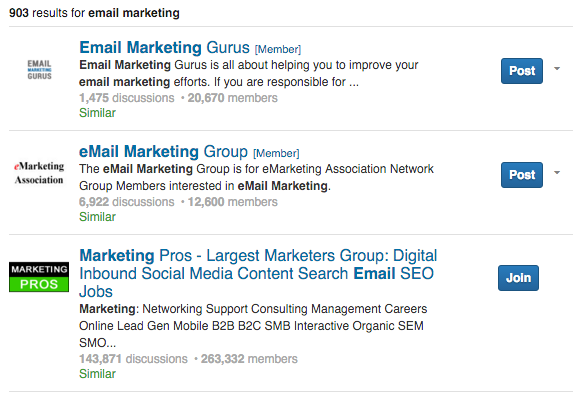
Step two: Next, read the rules! Most groups outline how to avoid getting banned for self-promotion. Check the group’s “About” page.
Step three: Introduce yourself. Generally, there is a pinned thread for introductions. Say hi and explain what you do. It’s okay to link to your site, but don’t start selling just yet.
Now it’s time to start commenting. Jump in to answer questions, provide guidance and congratulate other members. The goal is not to drive traffic directly, but to drive profile views. The more people visit your profile, the more they’ll click-through to your site (assuming you’ve optimized it!).
3. Start a Group
LinkedIn Groups are great for building communities, but there’s another hidden benefit that can help you drive traffic. Scott Van explains in his post How I Caught Copyblogger Sneaking into My Inbox:
When you subscribe to a LinkedIn group, unless you consciously decide to unsubscribe from email notifications, you will start regularly getting emails from LinkedIn triggered by activity inside the group.
Since LinkedIn is most likely tied to your primary email account, not some junk account set up to catch all those emails you subscribed to but didn’t really want to read, Copyblogger is regularly getting to the top of your inbox and they never once hit the send button on their email list.
Damn Copyblogger, that is really smart. Here’s what the emails look like:

Depending on how active your group is, emails arrive daily or weekly. They link first to the discussion, but users can click-through to read the full article on your site. The genius of it is that you can expand your email marketing efforts without sending more emails. LinkedIn does it for you.
Copyblogger takes it a step further too. You may remember that they killed comments on their blog. They encourage readers to discuss on LinkedIn instead.

That link takes people to the discussion group. If they want to comment, they need to join the group. If they join the group, they get the emails. What a beautifully executed strategy.
Obviously, the bigger and more active your group, the more traffic you can drive. Here are some tips for creating an active community.
- Link to it from your blog, a la Copyblogger.
- Send an invite to your email list and social media followers.
- Invite your LinkedIn contacts.
- Use a descriptive title and description so people can easily find you.
- Host interesting discussions with thought-leaders and experts.
- Regularly post new content and discussion topics.
- Appoint a moderator if you don’t have time to manage daily interactions.
- Ask members for feedback to improve your group.
- Read The Truly Monumental Guide to Building Online Communities from Mack Web.
4. Create a Company Page
A LinkedIn Company Page is place where people can learn more about what you do. Your employees’ personal profiles are great for sharing updates, but it’s a good idea to centralize everything within a company page.
It’s super easy to setup and there are instructions in the video below.
%(video)
Invision, a design collaboration tool, has done a great job making their page engaging. They provide a brief, clear description of what they do and regularly share updates about the company and their content.

To drive people to your company page, ask each of your employees to link to the company page from their personal profile. Once that’s done, all mentions of the company will link directly to the company page.

Company pages can also feature job postings and information about your product or service. As an added bonus, company pages rank well for branded organic searches.
5. Share Often
Just like like Facebook and Twitter, you need to share content from your personal profile and company page. Without a consistent, engaging stream of interesting, useful content, those static pages will start collecting dust.
Buffer has written a thorough guide to sharing on LinkedIn called LinkedIn Marketing: The All-in-One Guide to Content and Scheduling. Here are a few important highlights from this must-read post.
Industry insights perform exceptionally well on LinkedIn. Remember that most people use LinkedIn for professional networking. Unlike Twitter and Facebook which is a mix of personal and professional contacts, LinkedIn is a business platform. Meaty, useful content is celebrated here and click-bait isn’t tolerated.
LinkedIn reports that “60% of members are interested in industry insights.” Let’s not reinvent the wheel. That’s a definitive number that should dictate what you share on the site. If you haven’t created the right content yet, consider curating from other sources while you write. That will help you grow an audience to share your own work with.
Use images and videos. You probably already know that rich media — i.e. images, videos, slideshows and embedded content — drive more engagement than plain old text. LinkedIn has studied its own platform and found that including images in posts increases the comment rate by 98%!
When you add an update, LinkedIn will look for a thumbnail image to include. That’s nice, but go ahead and upload a higher resolution image with every post. The more descriptive and appealing the images, the more comments, likes and clicks. Remember also that when users engage with your post, it ends up in other users’ feeds.
The example below ended up in my feed because of a comment, not a direct connection.
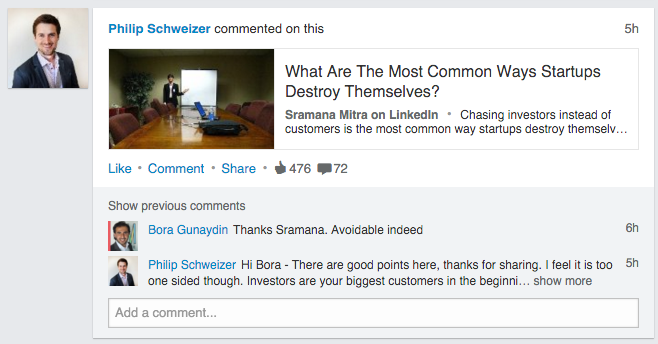
Video has a similar effect. According to LinkedIn’s Business Solutions team, “Links to YouTube videos play directly in the LinkedIn feed and usually result in a 75% higher share rate.”
What’s really cool about these stats is the compounding effect. The more you share good content with rich media, the more exposure you get. If you continue sharing, you’ll always be exposed to a larger and larger audience.
Don’t overshare. Buffer, known for their comprehensive guides on sharing frequency, suggests the following:
LinkedIn has found that 20 posts per month can help you reach 60 percent of your unique audience.
For those with the time, resources, and content to experiment with more than 20 per month, there’s this interesting nugget: LinkedIn’s best-in-class marketers post 3-4 updates per day, which would make for 80 posts per month.
Overall LinkedIn’s best advice on posting frequency is this: Post as many status updates as your content supports.
Given that you have a company page and a personal profile to share form, there are plenty of opportunities for exposure.
If you want to dive really deep into sharing frequency and post length, check out Buffer’s LinkedIn guide. It’s great stuff.
6. Add a LinkedIn Share Button to Your Site.
How do scale traffic from social sites?
You ask other people to do the work for you.
Sharing from your own LinkedIn profile is one way to drive traffic, but you’re limited to your network of peers on the site. It’s a great strategy, but it’s only scratching the surface.
Adding a LinkedIn button to your website is the easiest way to get other people sharing your content on the site. Even a handful of shares exposes your work to huge networks of potential customers.
And, of course, the easiest and best way to add a LinkedIn button to your site is Sumo’s Share tool. It’s totally free, takes just seconds to setup and gives you all the analytics you need to make decisions about the content you’re posting.
Greg Cypes, product management at AddThis, told Business Insider that LinkedIn shares carries more weight than Facebook or Twitter shares:
Linkedin Share is disproportionately powerful given the size of the network because "people care much more about what they're sharing [on Linkedin]," Cypes says. You can share all kinds of random nonsense on Facebook and Twitter — and no one cares, or remembers. On Linkedin, however, your future bosses and employees are watching. People think before they share.
Spend 37 seconds to add a LinkedIn share button to your site and let your readers take care of the rest.
7. Republish Content.
There is only one reason to post your content on sites other than your own: massive audiences.
LinkedIn’s 400 million users make the platform attractive to marketers looking to reach new readers. Help Scout writer and marketer Greg Ciotti wanted to see if LinkedIn’s publishing platform was worth his time and effort. Over the course of one month, he re-published 35 articles on LinkedIn. 255,262 views later, he wrote about the experience on his blog.
Granted, LinkedIn gets to keep those pageviews and run ads against them. This doesn’t count towards your own traffic, but it is a great opportunity to be discovered by new readers. It’s also a great way to drive people to offers like e-books and guides.
To accomplish this, Greg uses two simple strategies. First, he added a short bio at the bottom of each post that included links to Help Scout’s homepage and blog.
%(15)
Then, he added a call to action that directs readers to one of Help Scout’s customer support guides. By directing people to a specific resource, Greg has some room to sell its value.

His most popular post — Why Steve Jobs Didn't Listen to His Customers — has been read 260,000 times to date and surely drives a steady stream of traffic to back his site. The most beautiful part? He wrote the piece once but reaps the rewards of his work time and time again.
It’s important to emphasize that gaining traction on LinkedIn’s publishing platform is different than driving traffic to your own blog. Marketing and SEO expert Paul Shapiro wrote an article on the OkDork blog sharing his analysis of 3,000 successful LinkedIn posts. It’s a great post worth reading in its entirety, but here are a few useful nuggets from it.
- Use images, but not videos. The most successful posts included 8 images but very little rich media. This may seem counterintuitive considering that rich media tends to encourage comments and shares in shorter LinkedIn posts. But the data is clear:
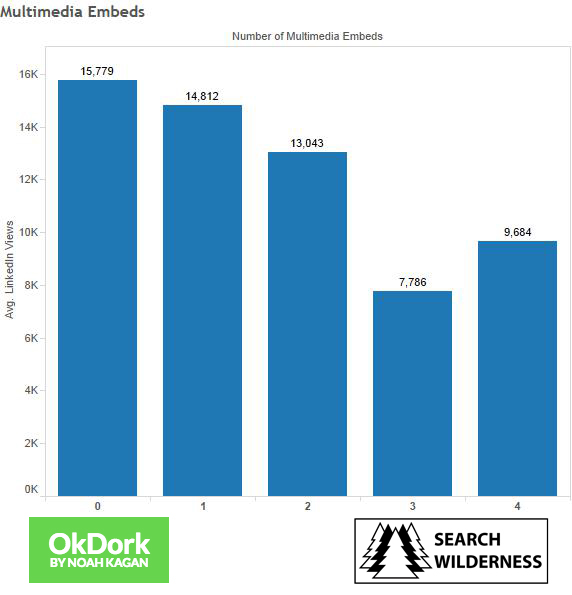
- Use catchy headlines, but don’t pose questions. As you might expect, lists and how-to posts generate the most traffic. When titles were posed as questions, the posts nearly always earned less traffic. Paul suggests the following advice for headline generation:
Don’t write headlines like:
“Do Business Schools Breed Arrogance?”
Write them like:
“Business Schools Breed Arrogance”
“12 Reasons Business Schools Breed Arrogance”
“How Business Schools Breed Arrogance”
- Don’t be afraid to go long. The most successful posts fell between 1,900 and 2,000 words. Remember that LinkedIn is a professional platform. People aren’t coming for entertain, they need information. If you can provide it, you can succeed.
Paul found a bunch of other great stuff too, which I’d encourage you to read.
8. Pay for it
Content marketing platform NewsCred ran some tests with LinkedIn Sponsored Updates and found they were able to generate $17 for every $1 they spend. Damn, that’s what we call ROI!
LinkedIn Sponsored Updates are used in tandem with the updates you are already posting from your company page. You can choose to “amplify” a post that you want to reach more people and you can target users based on all kinds of demographic data (job title, industry, education, location, etc.).
Here’s how a sponsored post looks in your feed:
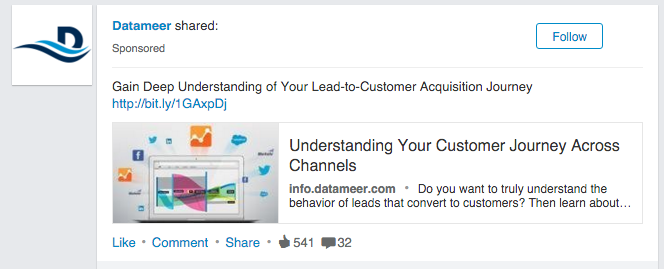
The issue with paying for traffic, of course, is that the visits stop when the money runs out.
Paying for traffic on LinkedIn can earn you followers as well as traffic however. Interestingly, NewsCred found that the cost per name (CPN) — i.e. the cost per lead generated — decreased over time.
That means that their content reaches more people for less money. It happens because the content reaches more people, which generates more followers, comments and likes, which increases organic reach.
Even more interesting, NewsCred reports that 60-65% of the leads were “medium-high or high quality” compared to just 20-30% on Google Adwords. Baller.
Okay, so you can get traffic, leads, more organic reach and the cost decreases over time…that’s a pretty sweet deal.
Be warned, however, that it’s very easy to waste money on paid acquisition if you don’t know what you’re doing. I’ve heard horror stories of forgotten campaigns that run for months before someone realizes the mistake.
Paid acquisition also requires rigorous testing and re-testing. If you want make $17 for every $1 you spend, you better be ready to earn it. You’ve got to have great content, interesting updates and strong calls to action. Don’t start paying for amplification until you’ve got all of this squared away.
That said, you’re trying to reach a B2B market, LinkedIn Sponsored Ads area a solid way to expand your reach and drive traffic to your website. For a deeper dive on Sponsored Ads, check out LinkedIn’s e-book Driving Quality Leads with Content.
Over To You
LinkedIn is a B2B marketer’s dream. It’s the best place to connect with professionals who are actually want your information. With the LinkedIn automation tools available today, scaling your network (and sales) becomes easier than ever.
If you’ve used a traffic generation strategy on LinkedIn that we didn’t mention here, let us know in the comments!
Add A Comment
VIEW THE COMMENTS